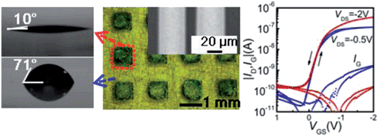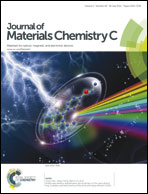Controlling the surface wettability of the polymer dielectric for improved resolution of inkjet-printed electrodes and patterned channel regions in low-voltage solution-processed organic thin film transistors
Abstract
A facile method for realizing both inkjet printed electrodes with improved resolution and patterned semiconductor islands was developed to fabricate all solution processed low-voltage organic thin film transistors (OTFTs). By reducing the surface wettability of the polymer gate dielectric layer through coating of a self-assembled monolayer (SAM), fine and narrow inkjet printed source/drain electrodes (a line width of about 35 μm) and short channels (about 15 μm) were formed with very good yield and uniformity using an inkjet printer with a 10 pL drop volume print head and limited registration accuracy. The coated SAM layer was then selectively removed by ultraviolet ozone treatment to create patterned wettable and less wettable regions to form self-assembled organic semiconductor islands. The fabricated low voltage OTFTs present a high quality semiconductor/dielectric interface and good device performance.


 Please wait while we load your content...
Please wait while we load your content...